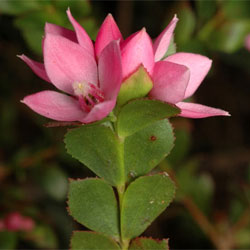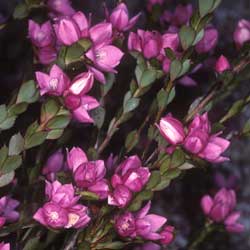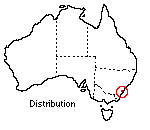Boronia serrulata
 |
 |
Native Rose
Boronia serrulata, or Native Rose, occurs naturally on the New South Wales central coast, within a radius of about 50 km of Sydney from Gosford to the Royal National Park, where it is found growing in semi-shade amongst outcrops of Hawkesbury sandstone.
 The
Native Rose forms an attractive upright shrub to 1 m high by 60 cm in diameter,
with crowded, bright green, rhomboid leaves, which turn bronze in frosty winters and are aromatic when crushed. In
spring the cup-shaped flowers appear in clusters at the end of the branches.
They are bright pink and have a refreshing fragrance.
The
Native Rose forms an attractive upright shrub to 1 m high by 60 cm in diameter,
with crowded, bright green, rhomboid leaves, which turn bronze in frosty winters and are aromatic when crushed. In
spring the cup-shaped flowers appear in clusters at the end of the branches.
They are bright pink and have a refreshing fragrance.
Propagation is by semi-hardwood cuttings taken in early summer. Seed germinates well after bushfires, but although some success has been achieved by chipping the hard seed coat and leaching in running water, this method of propagation is not reliable; further experimentation is needed to determine the conditions for germination.
For optimum growth B. serrulata should be grown in well-drained soil, in a raised rockery, preferably with some additional rocks placed around the root zone to give the plant a cool root run. A general fertiliser will be beneficial if applied in late winter and late summer.
Several plants of B. serrulata were grown at the Australian National Botanic Gardens for a number of years shaded by large eucalypts. These were planted with sandstone slabs around their roots several centimetres below the surface to give the roots a cool run. Plants have been lost due to poor drainage in heavy soils so this should be taken into account when selecting a planting site.
Leaf-eating caterpillars and root rot sometimes affect this species. The former is best controlled by removing the grub by hand rather than by spraying. The incidence of root rot is usually reduced by planting in well-drained conditions such as a rockery.
In summary B. serrulata is an attractive shrub all the year round. It is frost hardy, will tolerate heavy shade to almost full sun, makes an excellent specimen plant and performs well as a cut flower. It is usually available at commercial nurseries in Australia.
Text by Stuart Donaldson, ANBG (1981)
Name meaning: Boronia serrulataBoronia - after Francesco Borone (1769-94), an Italian plant collector; serrulata - from the Latin, serra, meaning saw, a reference to the fine serrations on the leaves. |
![An Australian Government Initiative [logo]](/images/austgovt_brown_90px.gif)

